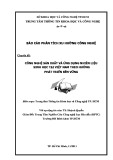
Chapter 3: Chapter 3: TRAPTRAP

3.2 3.2 Classification:Classification: four four
major types: major types:
Structural, Structural,
StratigraphicStratigraphic, ,
Hydrodynamic and Hydrodynamic and
CombinationCombination
3.1 3.1
Definitions and Definitions and
ConceptsConcepts

33..11..DefinitionsDefinitions andand ConceptsConcepts
••A trap is subsurface configuration of A trap is subsurface configuration of
reservoir rock and cap rock or seal that has reservoir rock and cap rock or seal that has
potential to concentrate petroleum in the potential to concentrate petroleum in the
pores of a reservoir rockpores of a reservoir rock
••A trap is a geological feature of a reservoir A trap is a geological feature of a reservoir
rock that restricts the flow of fluidsrock that restricts the flow of fluids
••A trap can content one or more reservoirsA trap can content one or more reservoirs


•The highest point of the trap is the crest or
culmination.
•The lowest point is the spill point. A trap may
or may not be full to the spill point.
•The horizontal plane through the spill point is
called the spill plane.
•The vertical distance from the high point at
the crest to the low point at the spill point is
the closure.








![Nhà máy lọc dầu Dung Quất: Đề tài nghiên cứu [Năm]](https://cdn.tailieu.vn/images/document/thumbnail/2013/20131114/online_12/135x160/2021384417941.jpg)









![Bài giảng Chế biến khoáng sản vô cơ [Mới nhất]](https://cdn.tailieu.vn/images/document/thumbnail/2025/20251025/thanhvan173002/135x160/21521761538638.jpg)







